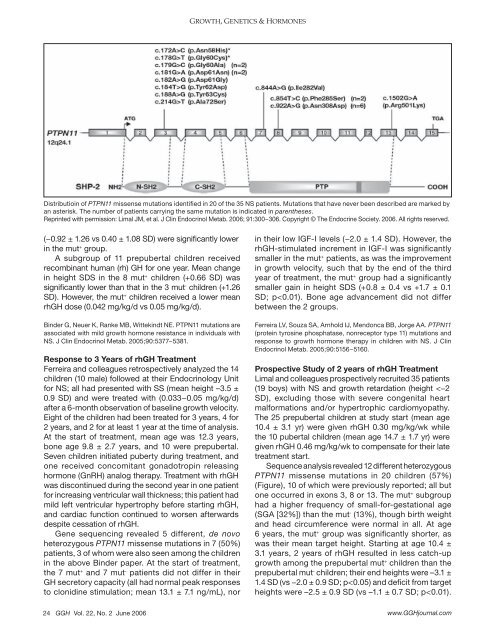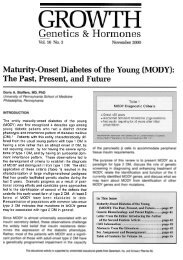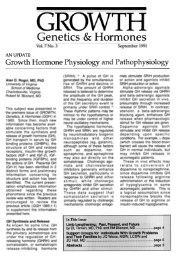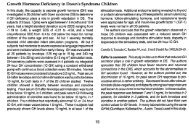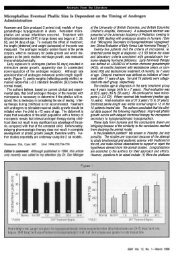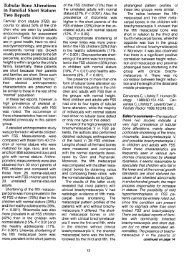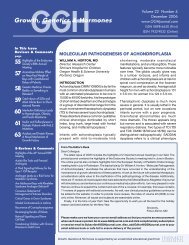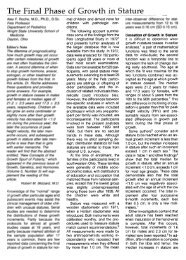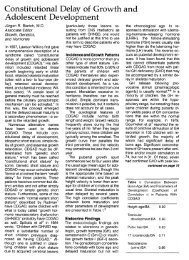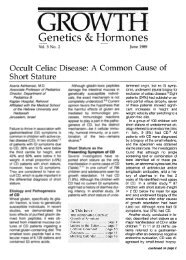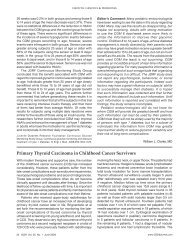Download pdf of current issue - GGH Journal
Download pdf of current issue - GGH Journal
Download pdf of current issue - GGH Journal
Create successful ePaper yourself
Turn your PDF publications into a flip-book with our unique Google optimized e-Paper software.
GROWTH, GENETICS & HORMONES<br />
Distributioin <strong>of</strong> PTPN11 missense mutations identified in 20 <strong>of</strong> the 35 NS patients. Mutations that have never been described are marked by<br />
an asterisk. The number <strong>of</strong> patients carrying the same mutation is indicated in parentheses.<br />
Reprinted with permission: Limal JM, et al. J Clin Endocrinol Metab. 2006; 91:300−306. Copyright © The Endocrine Society. 2006. All rights reserved.<br />
(−0.92 ± 1.26 vs 0.40 ± 1.08 SD) were significantly lower<br />
in the mut + group.<br />
A subgroup <strong>of</strong> 11 prepubertal children received<br />
recombinant human (rh) GH for one year. Mean change<br />
in height SDS in the 8 mut + children (+0.66 SD) was<br />
significantly lower than that in the 3 mut - children (+1.26<br />
SD). However, the mut + children received a lower mean<br />
rhGH dose (0.042 mg/kg/d vs 0.05 mg/kg/d).<br />
Binder G, Neuer K, Ranke MB, Wittekindt NE. PTPN11 mutations are<br />
associated with mild growth hormone resistance in individuals with<br />
NS. J Clin Endocrinol Metab. 2005;90:5377−5381.<br />
Response to 3 Years <strong>of</strong> rhGH Treatment<br />
Ferreira and colleagues retrospectively analyzed the 14<br />
children (10 male) followed at their Endocrinology Unit<br />
for NS; all had presented with SS (mean height –3.5 ±<br />
0.9 SD) and were treated with (0.033−0.05 mg/kg/d)<br />
after a 6-month observation <strong>of</strong> baseline growth velocity.<br />
Eight <strong>of</strong> the children had been treated for 3 years, 4 for<br />
2 years, and 2 for at least 1 year at the time <strong>of</strong> analysis.<br />
At the start <strong>of</strong> treatment, mean age was 12.3 years,<br />
bone age 9.8 ± 2.7 years, and 10 were prepubertal.<br />
Seven children initiated puberty during treatment, and<br />
one received concomitant gonadotropin releasing<br />
hormone (GnRH) analog therapy. Treatment with rhGH<br />
was discontinued during the second year in one patient<br />
for increasing ventricular wall thickness; this patient had<br />
mild left ventricular hypertrophy before starting rhGH,<br />
and cardiac function continued to worsen afterwards<br />
despite cessation <strong>of</strong> rhGH.<br />
Gene sequencing revealed 5 different, de novo<br />
heterozygous PTPN11 missense mutations in 7 (50%)<br />
patients, 3 <strong>of</strong> whom were also seen among the children<br />
in the above Binder paper. At the start <strong>of</strong> treatment,<br />
the 7 mut + and 7 mut - patients did not differ in their<br />
GH secretory capacity (all had normal peak responses<br />
to clonidine stimulation; mean 13.1 ± 7.1 ng/mL), nor<br />
in their low IGF-I levels (−2.0 ± 1.4 SD). However, the<br />
rhGH-stimulated increment in IGF-I was significantly<br />
smaller in the mut + patients, as was the improvement<br />
in growth velocity, such that by the end <strong>of</strong> the third<br />
year <strong>of</strong> treatment, the mut + group had a significantly<br />
smaller gain in height SDS (+0.8 ± 0.4 vs +1.7 ± 0.1<br />
SD; p


